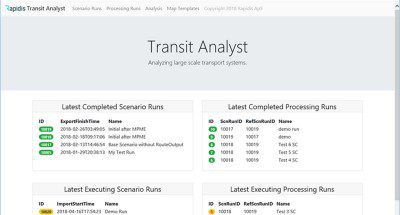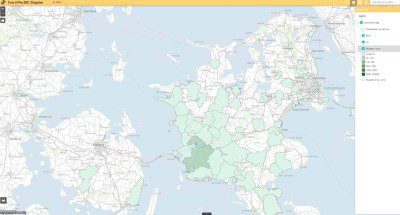Travelcard Analysis System based on Rapidis Transit Analyst for ArcGIS
The Travelcard Analysis System, a working system at Movia (Movia is the Regional Transit Authority for the Copenhagen and the Region of Zealand Region) is based on the Rapidis Transit Analyst for ArcGIS software and Esri ArcGIS Enterprise, that Rapidis deliver as an integrated solution.
The many examples on analysis below are shown with kind consent of Movia. See how Movia presented the early vision at the Esri Transportation Summit 2018 in London.
About the Travelcard Analysis System
The Travelcard Analysis System implemented at Movia is based on Rapidis Transit Analyst for ArcGIS and Esri ArcGIS Enterprise, that Rapidis deliver as a combined solution.
The model provides a new and very accurate picture of customers’ overall use of public transport in the Movia area.
More than passenger counts
For a specific stop or station counts show numbers for boarders and disembarkment.
Transit Analyst maps the entire trip and shows relations between boarding and disembarkment for all
lines and modes involved in a trip representing the need for transportation for a given passenger.
Calculate effects from proposed changes
Therefore it is now possible to map and understand how passengers are using the public transit system, what trips will be affected by proposed changes and forecast how passengers affected will change their trip in order to meet their need for transportation.
With this data it is simple to understand which lines, stops etc. will increase or decrease in passenger volume and other metrics.
Input for model calculations
Transit Analyst uses Multi-Path OD-Matrix Estimation (MPME) to join modeldata, time tables, counts and travel card data, to provide the best possible both complete and very detailed picture of all trips in the public transit system.
Output describes, in detail, every trip from embarkment to disembarkment for an average day within a category and within the selected time frame.
Input for the MPME is travel card data, available counts and journey plans. Together with the Rapidis Route
Choice Model for Public Transit these are the input for the model calculations.
Output from model calculations
Output is an estimated OD-Matrix which is validated with count until it reaches close to 100 % correctness.
Output also provide trips and GIS data for visualization.
More info about the Travelcard Analysis System
Please contact Leif Dahl Petersen for more information















